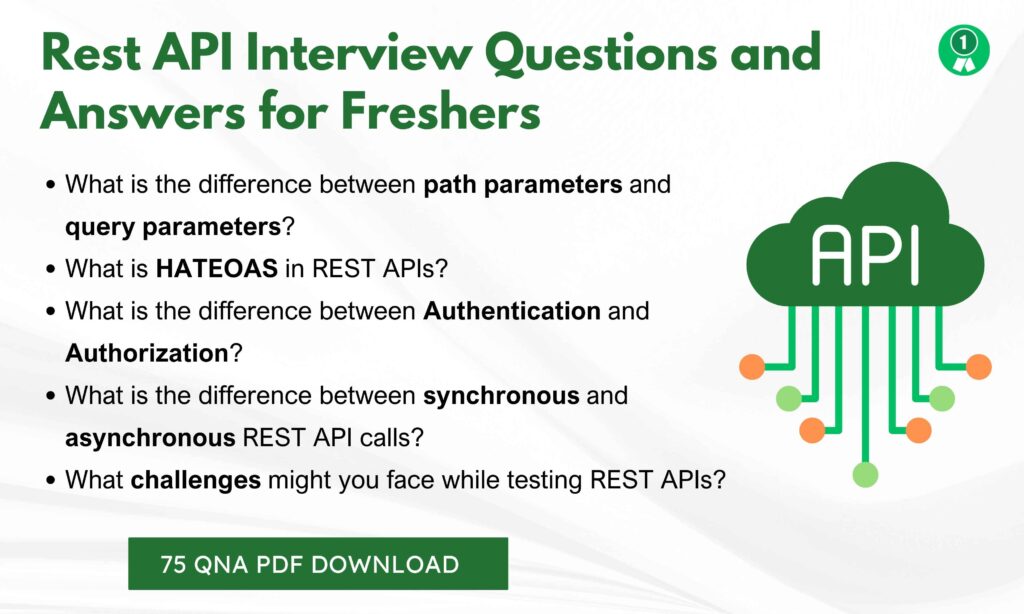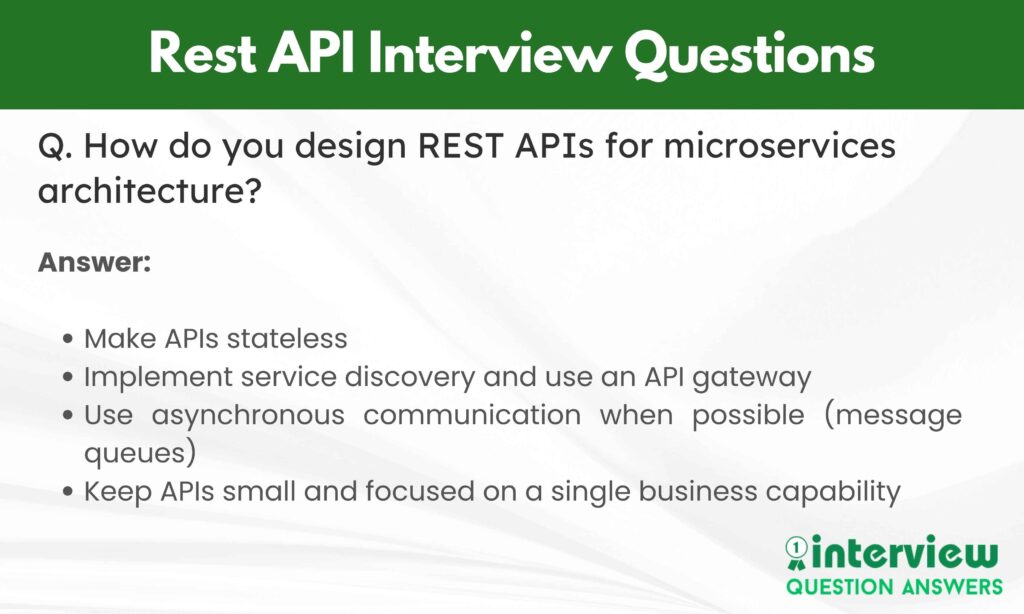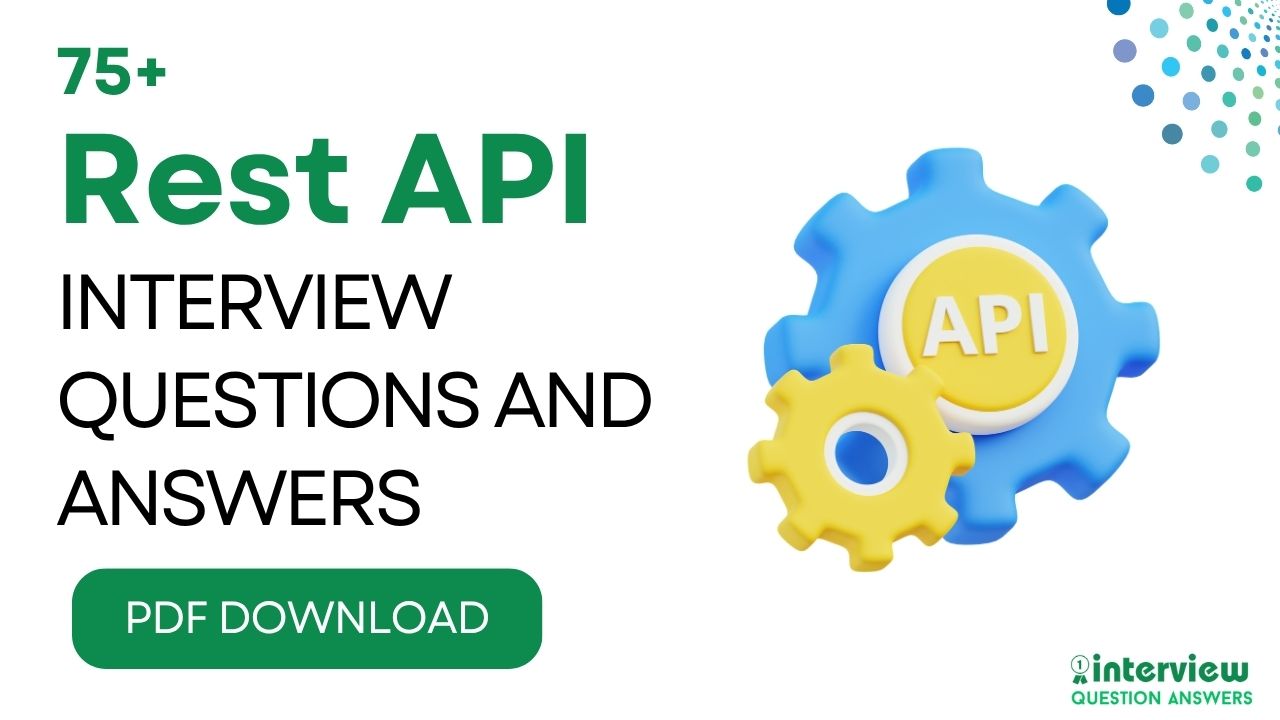REST API developers design and implement representational state transfer services that enable seamless communication between web applications, mobile apps, and various software systems through standardized HTTP protocols.
REST API professionals create scalable, stateless APIs that handle data retrieval, manipulation, and integration while following REST architectural principles and best practices. As modern applications increasingly rely on RESTful services for functionality and data exchange, companies actively seek developers who can build robust, efficient, and well-documented REST APIs.
Fresh graduates and experienced developers must demonstrate strong understanding of REST principles, HTTP methods, status codes, and practical implementation skills to succeed in today’s API-driven development landscape.
This comprehensive REST API interview guide delivers carefully curated questions and detailed answers tailored for developers at every career stage. We have added questions for both freshers and experienced professionals. Also added specialized sections covering Spring Boot, Java, and Python REST API development, addressing the most popular frameworks and languages in the industry.
Table of Contents
Rest API Interview Questions and Answers for Freshers
Que 1. What is the difference between REST and SOAP?
Answer:
- REST is lightweight, uses HTTP, and supports multiple formats like JSON and XML.
- SOAP is protocol-based, uses XML only, and includes built-in standards for security and transactions.
Que 2. What are common HTTP methods used in REST APIs?
Answer:
- GET: Retrieve data
- POST: Create new resource
- PUT: Update existing resource
- PATCH: Update partial resource
- DELETE: Remove resource
Que 3. What is the difference between PUT and PATCH?
Answer:
- PUT: Updates the entire resource and is idempotent.
- PATCH: Updates only specific fields of the resource.
Que 4. What are common HTTP status codes used in REST APIs?
Answer:
- 200 OK: Successful request
- 201 Created: Resource created
- 400 Bad Request: Invalid input
- 401 Unauthorized: Authentication required
- 404 Not Found: Resource doesn’t exist
- 500 Internal Server Error: Server failure
Que 5. What is the difference between path parameters and query parameters?
Answer:
| Type | Example |
|---|---|
| Path Parameter | /users/101 |
| Query Parameter | /users?id=101&status=active |
Que 6. How does REST ensure statelessness?
Answer: REST does not store client session data on the server. Each request contains all necessary information (headers, tokens) to process it independently.
Que 7. What is JSON and why is it popular in REST APIs?
Answer: JSON (JavaScript Object Notation) is a lightweight, human-readable data format. It is popular because it is easy to parse, widely supported, and integrates well with JavaScript.
Que 8. What is HATEOAS in REST APIs?
Answer: HATEOAS (Hypermedia As The Engine Of Application State) means API responses include links to guide the client about possible next actions.
Example:
{
"id": 1,
"name": "John",
"links": [
{"rel": "self", "href": "/users/1"},
{"rel": "orders", "href": "/users/1/orders"}
]
}Que 9. How do you handle errors in REST APIs?
Answer: Use proper HTTP status codes and return a structured error message:
{
"error": "Resource not found",
"code": 404
}Que 10. What is the difference between Authentication and Authorization?
Answer:
- Authentication: Verifies the identity of the user (e.g., login).
- Authorization: Checks user permissions to access a resource (e.g., admin access).
Que 11. What is CORS and why is it important in REST APIs?
Answer: CORS (Cross-Origin Resource Sharing) is a security feature that controls which domains can access API resources. Without proper CORS configuration, browsers may block cross-domain requests.
Que 12. How do you secure a REST API?
Answer:
- Use HTTPS
- Implement token-based authentication (JWT, OAuth2)
- Validate inputs and sanitize data
- Use rate limiting and API keys
Que 13. What is the difference between synchronous and asynchronous REST API calls?
Answer:
- Synchronous: The client waits until the server responds.
- Asynchronous: The server processes the request in the background and notifies the client later.
Que 14. How do you perform versioning in REST APIs?
Answer:
- URL-based: /v1/users
- Header-based: Accept-Version: 1.0
- Query-based: /users?version=1
Que 15. What challenges might you face while testing REST APIs?
Answer:
- Managing authentication tokens
- Validating large JSON responses
- Testing interdependent APIs
- Handling rate limits and timeouts

Also Check: Web API Interview Questions and Answers PDF
Rest API Interview Questions and Answers for Experience
Que 16. How do you implement API versioning in a REST API without breaking clients?
Answer:
API versioning can be done using:
- URL-based versioning: /v2/customers
- Header-based versioning: Accept: application/vnd.company.v2+json
- Query parameter versioning: /customers?version=2
Best practice is to avoid breaking changes and deprecate old versions gradually.
Que 17. What are idempotent methods in REST APIs and why are they important?
Answer:
Idempotent methods produce the same result when executed multiple times.
- Examples: GET, PUT, DELETE
- Importance: Prevents duplicate updates during retries in distributed systems.
Que 18. How do you handle partial updates in REST APIs?
Answer:
Use the PATCH method for partial updates instead of PUT:
PATCH /users/123
{
"email": "newemail@example.com"
}This updates only the provided fields without overwriting the full resource.
Que 19. What strategies can be used to improve REST API performance?
Answer:
- Enable caching using ETag and Cache-Control
- Implement pagination for large data sets
- Optimize database queries
- Use content compression (GZIP)
- Reduce payload size using selective fields
Que 20. How do you implement rate limiting in REST APIs?
Answer:
Use algorithms like Token Bucket or Leaky Bucket. Return 429 Too Many Requests when the client exceeds allowed requests.
Example header:
X-Rate-Limit-Limit: 100
X-Rate-Limit-Remaining: 0
X-Rate-Limit-Reset: 60 Que 21. What is the difference between 401 Unauthorized and 403 Forbidden in REST APIs?
Answer:
| Code | Meaning |
|---|---|
| 401 | Authentication required or failed |
| 403 | Authenticated but does not have permission |
Que 22. How do you secure REST APIs against CSRF attacks?
Answer:
- Use CSRF tokens for state-changing requests
- Enforce same-origin policy and CORS configuration
- Require custom headers for AJAX calls
Que 23. How do you handle large file uploads in REST APIs?
Answer:
- Use multipart/form-data with chunked uploads
- Support resumable uploads
- Validate file size, type, and scan for malware before saving
Que 24. How can REST APIs support asynchronous operations?
Answer:
- Use
202 Acceptedresponse with a status URL:
POST /reports
202 Accepted
Location: /reports/status/123- Client polls the status URL or use webhooks/callbacks for completion updates.
Que 25. How do you implement caching in REST APIs?
Answer:
- Client-side caching: Use
Cache-Control,Expiresheaders - Server-side caching: Store frequently requested data in Redis or Memcached
- Use
ETagheaders to validate freshness of data.
Que 26. What is HATEOAS and why is it important?
Answer:
HATEOAS (Hypermedia as the Engine of Application State) makes APIs self-discoverable by including links in responses:
{
"id": 5,
"name": "Invoice",
"links": [
{"rel": "self", "href": "/invoices/5"},
{"rel": "pay", "href": "/invoices/5/pay"}
]
}Que 27. How do you ensure backward compatibility while evolving REST APIs?
Answer:
- Avoid removing fields abruptly
- Add new fields without breaking existing clients
- Use default values for missing parameters
- Support multiple versions simultaneously during transitions
Que 28. How do you protect REST APIs from brute force and DoS attacks?
Answer:
- Implement rate limiting and throttling
- Use API gateways with WAF (Web Application Firewall)
- Implement captcha or account lockouts on repeated failed logins
Que 29. How do you implement pagination in REST APIs?
Answer:
- Offset-based pagination: /users?offset=50&limit=20
- Cursor-based pagination: /users?cursor=xyz&limit=20
Cursor-based is preferred for large datasets because it avoids performance issues with deep offsets.
Que 30. How do you design REST APIs for microservices architecture?
Answer:
- Make APIs stateless
- Implement service discovery and use an API gateway
- Use asynchronous communication when possible (message queues)
- Keep APIs small and focused on a single business capability

Also Check: API Testing Interview Questions
Spring Boot Rest API Interview Questions and Answers
Que 31. How do you create a simple REST endpoint in Spring Boot?
Answer:
Use @RestController and map methods with @GetMapping, @PostMapping, etc.
@RestController
@RequestMapping("/api")
public class ProductController {
@GetMapping("/products")
public List<Product> getProducts() {
return productService.findAll();
}
}Que 32. What is the difference between @Controller and @RestController in Spring Boot?
Answer:
- @Controller: Used for web applications; returns views by default.
- @RestController: Combines @Controller and @RestController to return JSON/XML directly as a response.
Que 33. How do you handle exceptions globally in Spring Boot REST APIs?
Answer:
Use @ControllerAdvice and @ExceptionHandler:
@ControllerAdvice
public class GlobalExceptionHandler {
@ExceptionHandler(ResourceNotFoundException.class)
public ResponseEntity<String> handleNotFound(ResourceNotFoundException ex) {
return ResponseEntity.status(HttpStatus.NOT_FOUND).body(ex.getMessage());
}
}Que 34. How do you validate request data in Spring Boot REST APIs?
Answer:
Use @Valid with javax.validation annotations:
public class User {
@NotBlank private String name;
@Email private String email;
}
@PostMapping("/users")
public ResponseEntity<User> createUser(@Valid @RequestBody User user) { ... }Que 35. How do you implement pagination and sorting in Spring Boot?
Answer:
Use Spring Data JPA’s Pageable:
@GetMapping("/products")
public Page<Product> getProducts(Pageable pageable) {
return productRepository.findAll(pageable);
}Que 36. How do you secure REST APIs in Spring Boot?
Answer:
- Use Spring Security with Basic Auth, JWT, or OAuth2.
- Add @EnableWebSecurity and configure authentication/authorization rules.
- Example: Token-based JWT authentication is widely used.
Que 37. How do you enable CORS in Spring Boot REST APIs?
Answer:
- Method-level:
@CrossOrigin(origins = "http://localhost:3000")
@GetMapping("/products")
public List<Product> getProducts() { ... }- Global level: Define a WebMvcConfigurer bean and override addCorsMappings().
Que 38. How do you implement content negotiation in Spring Boot?
Answer:
Spring Boot uses the Accept header to choose the response type. You can configure supported media types:
@GetMapping(value = "/products", produces = {"application/json", "application/xml"})
public List<Product> getProducts() { ... }Que 39. What is the difference between @RequestParam and @PathVariable?
Answer:
| Annotation | Usage Example |
|---|---|
@RequestParam | /products?id=10 |
| @PathVariable | /products/10 |
@RequestParam is for query parameters, while @PathVariable is for path segments. |
Que 40. How do you consume external REST APIs in Spring Boot?
Answer:
Use RestTemplate or WebClient:
RestTemplate restTemplate = new RestTemplate();
String result = restTemplate.getForObject("https://api.example.com/data", String.class);Que 41. How do you implement API versioning in Spring Boot?
Answer:
- URL versioning: /api/v1/products
- Header versioning: X-API-VERSION: 1
Example:
@GetMapping("/v1/products")
public List<Product> getProductsV1() { ... }Que 42. How do you test REST APIs in Spring Boot?
Answer:
Use MockMvc for integration testing:
mockMvc.perform(get("/products"))
.andExpect(status().isOk())
.andExpect(jsonPath("$[0].name").value("Laptop"));Que 43. How do you implement file upload/download in Spring Boot REST APIs?
Answer:
@PostMapping("/upload")
public ResponseEntity<String> upload(@RequestParam("file") MultipartFile file) { ... }
@GetMapping("/download/{filename}")
public ResponseEntity<Resource> download(@PathVariable String filename) { ... }Que 44. How do you monitor Spring Boot REST APIs?
Answer:
Use Spring Boot Actuator for metrics, health endpoints, and monitoring. Integrate with tools like Prometheus, Grafana, or ELK for detailed insights.
Que 45. What is the advantage of using Spring Boot for building REST APIs?
Answer:
Spring Boot simplifies REST API development by providing embedded servers (Tomcat/Jetty), auto-configuration, production-ready features (metrics, health checks), and minimal boilerplate code. It integrates well with Spring MVC, making REST endpoints easy to create.
Java Rest API Interview Questions and Answers
Que 46. How do you create a simple REST endpoint using JAX-RS in Java?
Answer:
@Path("/products")
public class ProductResource {
@GET
@Produces(MediaType.APPLICATION_JSON)
public List<Product> getProducts() {
return productService.getAllProducts();
}
}Que 47. What is the difference between @PathParam and @QueryParam in JAX-RS?
Answer:
| Annotation | Example URL | Usage |
|---|---|---|
| @PathParam | /products/123 | Extracts value from the path segment |
| @QueryParam | /products?id=123 | Extracts value from the query string |
Que 48. How do you handle JSON serialization in Java REST APIs?
Answer:
Use libraries like Jackson or Gson.
Example with Jackson:
ObjectMapper mapper = new ObjectMapper();
String json = mapper.writeValueAsString(product);Spring Boot and JAX-RS automatically use Jackson for JSON binding.
Que 49. How do you handle exceptions globally in a Java REST API?
Answer:
Use @Provider with ExceptionMapper:
@Provider
public class GlobalExceptionHandler implements ExceptionMapper<Exception> {
public Response toResponse(Exception e) {
return Response.status(500).entity(e.getMessage()).build();
}
}Que 50. How do you secure Java REST APIs with Basic Authentication?
Answer:
- Use javax.ws.rs.container.ContainerRequestFilter to intercept requests.
- Check the Authorization header for valid credentials.
- Alternatively, integrate with frameworks like Spring Security for simplified authentication.
Que 51. What is the difference between synchronous and asynchronous REST endpoints in Java?
Answer:
- Synchronous: The request thread blocks until the response is returned.
- Asynchronous: Uses callbacks and non-blocking I/O for better scalability.
Example with JAX-RS:
@GET
public void getData(@Suspended AsyncResponse response) {
executor.submit(() -> response.resume(service.loadData()));
}Que 52. How do you implement pagination in Java REST APIs?
Answer:
- Use query parameters: /products?page=1&size=20
- Return metadata in the response:
{
"data": [...],
"page": 1,
"size": 20,
"total": 100
}Que 53. How do you implement versioning in Java REST APIs?
Answer:
- URL-based: /v1/products
- Header-based: Accept: application/vnd.company.v1+json
- Query parameter: /products?version=1
Que 54. How do you enable CORS in Java REST APIs?
Answer:
Implement a ContainerResponseFilter:
@Provider
public class CORSFilter implements ContainerResponseFilter {
public void filter(ContainerRequestContext request, ContainerResponseContext response) {
response.getHeaders().add("Access-Control-Allow-Origin", "*");
}
}Que 55. How do you handle file uploads in Java REST APIs?
Answer:
Use @FormDataParam with JAX-RS:
@POST
@Consumes(MediaType.MULTIPART_FORM_DATA)
public Response uploadFile(@FormDataParam("file") InputStream fileInputStream) { ... }Que 56. How do you implement HATEOAS in Java REST APIs?
Answer:
Add links to the resource in the response:
{
"id": 5,
"name": "Order",
"links": [
{"rel": "self", "href": "/orders/5"},
{"rel": "cancel", "href": "/orders/5/cancel"}
]
}Que 57. How do you implement caching in Java REST APIs?
Answer:
- Use HTTP caching headers like Cache-Control and ETag.
- Example:
return Response.ok(data)
.cacheControl(CacheControl.valueOf("max-age=3600"))
.tag(etag)
.build();Que 58. How do you test Java REST APIs?
Answer:
- Use JUnit with RestAssured or MockMvc (for Spring-based APIs).
- Example with RestAssured:
given().get("/products").then().statusCode(200);Que 59. How do you design REST APIs for microservices in Java?
Answer:
- Keep services small and focused
- Use Spring Cloud or Eureka for service discovery
- Implement API gateways for routing and security
- Ensure APIs are stateless and use asynchronous communication where needed
Sure, here’s a shorter version:
Que 60. How would you design a RESTful API endpoint for retrieving a list of books, ensuring that it supports pagination and filtering by genre?
To design a RESTful API endpoint for retrieving a list of books with pagination and filtering by genre, you can use the following approach:
Endpoint: GET /books
Query Parameters:
page: The page number for pagination (e.g.,page=1).limit: The number of items per page (e.g.,limit=10).genre: The genre to filter by (e.g.,genre=fiction)
Example Request:
GET /books?page=1&limit=10&genre=fictionResponses:
200 OK: Returns a paginated list of books in the specified genre.400 Bad Request: The request is malformed or invalid.404 Not Found: No books found matching the criteria.
This design ensures that the API is user-friendly and efficient, supporting both pagination and filtering by genre.
Also Check: Java interview Questions and Answers
Python Rest API Interview Questions and Answers
Que 61. Which Python frameworks are most commonly used to build REST APIs?
Answer:
The most popular frameworks include Flask, Django Rest Framework (DRF), FastAPI, and Falcon.
- Flask: Lightweight and flexible
- DRF: Built on Django, includes authentication and serialization
- FastAPI: High performance, supports async
Que 62. How do you create a basic REST endpoint in Flask?
Answer:
from flask import Flask, jsonify
app = Flask(__name__)
@app.route('/products', methods=['GET'])
def get_products():
return jsonify({"products": ["Laptop", "Phone"]})
if __name__ == '__main__':
app.run(debug=True)Que 63. What is the difference between Flask and Django Rest Framework?
Answer:
- Flask: Micro-framework, more control but requires manual setup for authentication, serialization, etc.
- DRF: Full-featured, built-in ORM, serializers, and permissions; better for large applications.
Que 64. How do you handle JSON input and output in a Python REST API?
Answer:
Using Flask:
from flask import request, jsonify
data = request.get_json()
return jsonify(data)Using DRF:
return Response(serializer.data)Que 65. How do you implement authentication in Python REST APIs?
Answer:
- Use token-based authentication (JWT) with libraries like PyJWT or built-in DRF tokens.
Example (Flask-JWT-Extended):
from flask_jwt_extended import JWTManager, create_access_token
jwt = JWTManager(app)
token = create_access_token(identity="user1")Que 66. How do you handle exceptions globally in a Python REST API?
Answer:
- In Flask:
@app.errorhandler(404)
def not_found(error):
return jsonify({"error": "Not Found"}), 404- In DRF: Implement exception_handler in settings.py
Que 67. How do you add query parameters and path parameters in Flask?
Answer:
- Query parameter: /products?id=1
id = request.args.get('id')- Path parameter: /products/<id>
@app.route('/products/<int:id>')
def get_product(id):
...Que 68. How do you enable CORS in a Python REST API?
Answer:
Use Flask-CORS:
from flask_cors import CORS
CORS(app)Que 69. How do you implement pagination in Python REST APIs?
Answer:
page = int(request.args.get('page', 1))
limit = int(request.args.get('limit', 10))
items = Product.query.paginate(page=page, per_page=limit)In DRF, use PageNumberPagination or LimitOffsetPagination classes.
Que 70. How do you implement API versioning in Python REST APIs?
Answer:
- URL-based: /api/v1/products
- Namespace-based in Flask-RESTful:
api = Api(app, prefix="/api/v1")- DRF: Use NamespaceVersioning or URLPathVersioning.
Que 71. How do you handle file uploads in Python REST APIs?
Answer:
file = request.files['file']
file.save(f"./uploads/{file.filename}")In DRF, use FileField or ImageField in serializers.
Que 72. How do you implement caching in Python REST APIs?
Answer:
Use Flask-Caching:
from flask_caching import Cache
cache = Cache(app, config={'CACHE_TYPE': 'simple'})
@cache.cached(timeout=60)
def get_data():
...Que 73. How do you handle async requests in Python REST APIs?
Answer:
- Use FastAPI with async def endpoints.
@app.get("/data")
async def get_data():
return {"data": "async response"}Que 74. How do you test Python REST APIs?
Answer:
- Use pytest, unittest, or requests library.
Example:
import requests
resp = requests.get("http://localhost:5000/products")
assert resp.status_code == 200Que 75. How do you protect Python REST APIs from brute force or DoS attacks?
Answer:
- Implement rate limiting using Flask-Limiter:
from flask_limiter import Limiter
limiter = Limiter(app, default_limits=["100 per hour"])- Use API gateways and secure authentication mechanisms.
Also Check: Python Interview Questions and Answers
Rest API Interview Questions PDF
We have added Rest API Interview Questions to a PDF you can access the guide anytime easily anytime.
FAQs: Rest API Interview Questions
What is the job role of a REST API developer?
A REST API developer is responsible for designing, developing, and maintaining APIs that allow different software systems to communicate. They ensure APIs are scalable, secure, and follow RESTful best practices while integrating with front-end applications, mobile apps, and third-party services.
What challenges do REST API developers face in their jobs?
Common challenges include ensuring backward compatibility during API updates, handling large volumes of requests, implementing strong security measures, maintaining high performance, and properly documenting APIs for internal and external use.
What difficulties might candidates face in a REST API interview?
Candidates are often tested on real-world problem-solving scenarios such as designing scalable endpoints, error handling, securing APIs with authentication and authorization, and managing versioning without breaking existing clients.
What is the average salary of a REST API developer in the USA?
The average salary of a REST API developer in the USA ranges from $95,000 to $125,000 annually. Senior developers and architects with advanced experience in microservices, cloud platforms, and security can earn upwards of $140,000–$150,000 per year.
What skills are required for a REST API developer role?
A REST API developer should have expertise in HTTP protocols, JSON/XML, authentication (JWT, OAuth2), API design patterns, and versioning. They should also be proficient in at least one backend language (Java, Python, Node.js, etc.), and frameworks like Spring Boot, Django REST Framework, or Express.js.
Which companies hire REST API developers?
Top companies include Amazon, Google, Microsoft, Meta, Salesforce, IBM, Accenture, Infosys, TCS, and Cognizant, along with numerous fintech, SaaS, and e-commerce companies that heavily rely on APIs.
How can someone grow their career as a REST API developer?
Developers can grow by learning advanced topics like API security, GraphQL, microservices architecture, cloud-native API management, and distributed systems. They can also move into roles such as Solutions Architect, API Product Manager, or full-stack engineer for broader opportunities.
Conclusion
Master REST API interviews with our comprehensive question bank covering all experience levels and popular technologies. From basic concepts to advanced Spring Boot, Java, and Python implementations, this guide prepares you for success. Download the PDF for offline study and confidently ace your REST API developer interviews.







